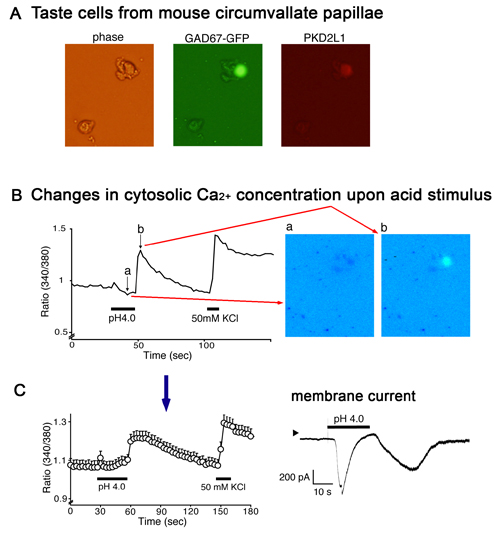Five basic tastes (bitter, sweet, umami, salty and sour) are detected in the four taste areas where taste buds reside. While molecular mechanisms for detecting bitter, sweet and umami have been well clarified, those for sour and salty remain poorly understood. Several channels including Acid Sensing Ion Channels (ASIC) have been proposed as candidate sour receptors, but they do not encompass all sour sensing abilities in vivo. We recently reported a novel candidate for sour sensing, the Polycystic Kidney Disease-2-Like 1 (PKD2L1)/PKD1L3 channel complex. This channel is not a traditional ligand-gated channel, and is gated open only after removal of an acid stimulus, called an off-response. Here we show that off-responses upon acid stimulus are clearly observed in native taste cells from circumvallate, but not fungiform papillae of glutamate decarboxylase 67 (GAD67)-GFP knock-in mice, from which Type III taste cells can be visualized, using Ca2+-imaging and patch-clamp methods. Off-responses were detected in most cells where PKD2L1-immunoreactivity was observed. Interestingly, the pH threshold for acid-evoked intracellular Ca2+ increase was around 5.0, a value much higher than that observed in HEK293 cells expressing the PKD2L1/PKD1L3 complex. Thus, PKD2L1/PKD1L3-mediated acid-evoked off-responses occurred both in HEK293 cells and in native taste cells, suggesting the involvement of the PKD2L1/PKD1L3 complex in acid sensing
Hitoshi Kawaguchi, Akihiro Yamanaka, Kunitoshi Uchida, Koji Shibasaki, Takaaki Sokabe, Yutaka Maruyama, Yuchio Yanagawa, Shingo Murakami, Makoto Tominaga and J. Biol. Chem.
285(23): 17277-17281, 2010.
This is a collaboration with Nagota City University (Prof. Murakami), Gunma University Graduate School of Medicine (Prof. Yanagawa) and Ajinomoto Co., Inc.

(A) Type III taste cells can be identified with GFP signal in the taste cells isolated from circumvallate papillae of GAD67 (glutamate decarboxylase 67)-GFP mouse. The type III cells also express PKD2L1 protein visualized by immunostaining with an anti-PKD2L1 antibody.
(B) A representative trace for change in cytosolic Ca2+ concentration ([Ca2+]i) (340/380 nm ratio) of the cell positive for both GFP and PKD2L1 shown in (A). Pseudo-color images at time points a and b indicated in the left trace are also shown. A small [Ca2+]i increase during the acid (pH 4.0) stimulus (on-response) and a large ([Ca2+]i increase after the acid stimulus (off-response).
(C) Traces of [Ca2+]i changes (mean + SEM) in response to acid (pH 4.0) and 50 mM KCl by circumvallate taste cells in the presence of extracellular Ca2+ (left). A representative membrane current in response to pH 4.0 stimulus in a circumvallate taste cell (right). Membrane currents were recorded at a holding potential of -60 mV. Arrowheads indicate 0 current level.